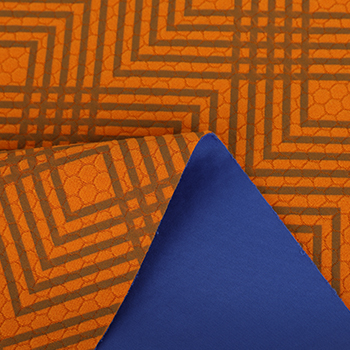Packcloth is a tough, durable, nylon fabric used for luggage, backpacks, book bags, and tarps. Since most of the fabric is waterproofed, it does not breathe. Keep the cloth out of puddles and seal the seams to keep Fashion outdoor fabric water out. Packcloth is both lighter in weight and stronger than cotton canvas. Our packcloth generally consists of fabrics in the denier range. A denier is the gauge or thickness of a yarn, commonly specific to nylon fabrics, and is defined as the thickness of one gram of fiber stretched out in a filament one quarter of a mile long.Contains nylon.Cordura cloth is like packcloth but tougher and more durable. It is resistant to abrasion but will readily damage other fabrics with which it comes into contact. We stock denier. Seams must be sealed to maintain water protection.

Uses include backpacks, luggage, sea bags, duffel bags, and sophisticated rock climbing packs.Ballistics cloth is a heavier packcloth with a denier of . Since Ballistics has a higher thread count per square inch, it is heavier than Cordura. Ballistics cloth is not abrasive, and is usually sold with a waterproof coating on it. Contains nylon. For uses, see Cordura.Today’s fleece fabric is a high-tech, high performance, outdoor apparel product that is very easy to sew because it’s extremely forgiving. Fleece is extremely warm and soft to the touch. It wicks away moisture from the body, so it feels dry, even when soaking wet. Fleece offers tremendous warmth in comparison to its weight and offers high fashion colors, textures, and designs. Fleece fabric is made by first twisting fibers into yarn, then knitting the yard into fabric. To raise the fibers and create a downy surface, the fabric is brushed with wire brushes.
This process makes the cloth compact. Finally the fleece is then sheared and finished. Uses include mittens, jackets, blankets, socks, pants, sleepers, and anything else that needs to be soft and warm.Neoprene is an extremely versatile synthetic rubber and was originally developed as an oil-resistant substitute for natural rubber. Neoprene is noted for a unique combination of properties, which has led to its use in thousands of applications in diverse environments from car fan belts to wet suits, waders, insulated can holders, sports gloves, pet collars, and elbow or knee pads.It resists degradation from sun, ozone and weather, remains useful over a wide temperature range, displays outstanding physical toughness, and has outstanding resistance to damage caused by flexing and twisting. Neoprene will conserve your natural body heat but it does so at the cost of keeping you damp if you’ve gotten wet.
Recommended care carefully, thoroughly rinse and let air dry completely. Store in a cool, dry and dark place.No-see-um netting, aka Mosquito Netting, is so finely woven that it prevents not only mosquitoes and black flies but even the tiniest of no-see-ums from getting to you. Soft, flexible, lightweight, bug proof polyester netting is great for repairing your tent or making a bug shirt or hood.These 100% nylon outdoor apparel fabrics have poor absorbency which is why they dry so quickly, and have good abrasion resistance. Nylon is highly durable and resistant to moths, mildew, and most chemicals. It is also wind resistant and colorfast.Ripstop is woven with a combination of lighter and heavier threads to form a grid-like pattern. Uses include tents, tent awnings, sleeping bags, kites, light jackets, pants, tarps, stuff packs and windbreakers.Taffeta is lightweight with a high thread count. Taffetas with a thread count of 160×90 or more are downproof. They can be used for many of the same applications as Ripstop and are commonly used as lining for insulated jackets.


